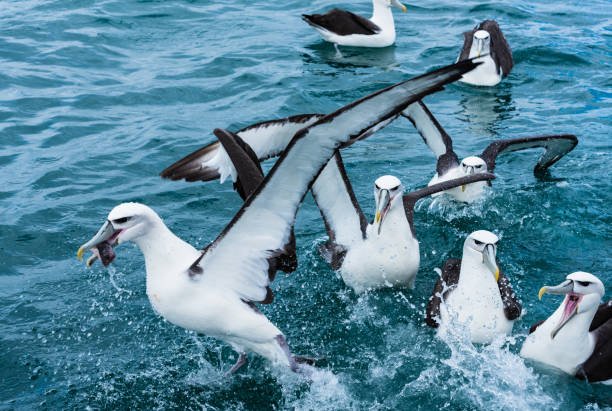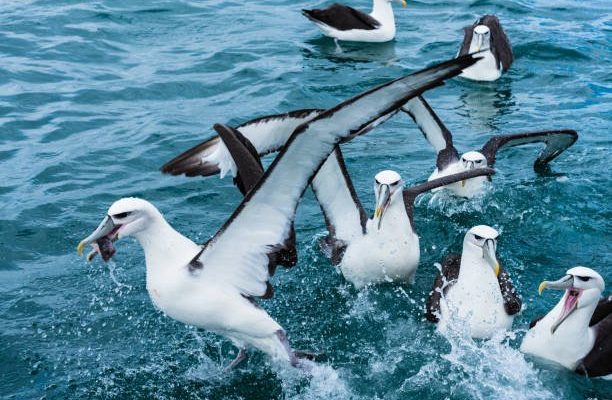
These birds have an incredible ability to travel long distances, sometimes covering thousands of miles in search of food. But how do they do it? The answer lies in their unique diet and clever hunting techniques. Albatrosses are not your average seabirds; they’ve honed their skills over millions of years to thrive in one of the most demanding environments on Earth. Let’s dive in and explore the gourmet menu of the albatross and how they make their meals happen.
What Do Albatrosses Eat?
Albatrosses are primarily scavengers and opportunistic feeders. Their diet mainly includes a mix of fish, squid, and other marine creatures. But this doesn’t mean they’re picky eaters. They’ll happily munch on whatever they can find, which is actually pretty smart given their vast ocean habitat.
Here’s a breakdown of their favorite meals:
- Fish: They often eat small fish that swim near the surface.
- Squid: Squid is particularly popular, especially during their breeding season when these creatures are abundant.
- Krill: Tiny shrimp-like creatures, krill are also a staple in their diet, especially for those nesting in colder waters.
One interesting fact is that albatrosses are great foragers; they can spot food from high above while flying. Their keen eyesight helps them detect schools of fish or the shimmering surface of squid. Honestly, it’s like having front-row seats to an endless aquatic buffet!
Hunting Techniques of the Albatross
So how do these remarkable birds catch their meals? Albatrosses have developed some unique hunting strategies that allow them to excel in their environments. Here are a couple of their go-to methods:
- Dynamic Soaring: This technique involves using wind currents to gain altitude and then gliding down to the ocean’s surface to snatch up food. By riding the wind, they conserve energy while covering vast distances.
- Surface Feeding: When they spot food from above, albatrosses can land on the water and dip their beaks to catch fish and squid swimming just beneath the surface.
Here’s the thing: watching an albatross hunt is like witnessing a dance. They seem to effortlessly glide, swoop, and dive, showcasing their masterful control over the air and sea. They can fly for hours without flapping their wings, saving energy for those crucial moments when they need to strike.
Role of Scavenging in Their Diet
While albatrosses are skilled hunters, they’re also savvy scavengers. You might be wondering why scavenging is so important to their diet. Well, it’s all about opportunities. When a dead fish or squid floats to the surface, it’s a feast waiting to be devoured.
Albatrosses often follow fishing boats to take advantage of discarded bycatch. This strategy not only provides them with an easy meal but also helps them conserve energy. Think of it this way: it’s like finding a snack at a friend’s house without having to cook!
But this scavenging habit is a double-edged sword. With the increasing presence of plastic and other pollution in the oceans, what they consume is becoming a concern. The health of the oceans directly impacts these birds, making the protection of marine ecosystems crucial.
Feeding Habits During Breeding Season
During breeding season, albatrosses have to adapt their feeding strategies. Raising chicks requires lots of energy, and the parents need to bring back nutritious food. This means longer foraging trips to find the right meals.
Interestingly, albatross parents often take turns hunting. One will stay to care for the chick while the other heads out to find food. This cooperative effort ensures the chick gets fed and reduces the risk of starvation.
Once they return from foraging, the parents regurgitate food for the chick. It might sound a bit gross, but for albatrosses, this is just how they do it! It’s a perfect way to provide their young with the nutrients they need to grow strong.
Impact of Climate Change on Albatross Diet
Climate change is starting to show its effects on the albatross and their diet. Changes in ocean temperatures can shift the distribution of fish and squid, making it harder for these birds to find food. When they can’t hunt as efficiently, it directly affects their breeding success and overall population health.
You might think about how the changing climate also leads to altered weather patterns. Strong winds and storms can make it tough for albatrosses to forage effectively, forcing them to expend more energy just to find food. As their hunting ability becomes compromised, the ripple effects can affect entire breeding colonies.
Understanding these challenges is crucial for conservation efforts aimed at protecting albatross populations. Supporting sustainable fishing practices and addressing climate change are vital steps in ensuring their survival.
The diet and hunting strategies of the albatross are remarkable examples of adaptation and skill in the natural world. From their impressive foraging techniques to their ability to scavenge, they showcase resilience in the face of environmental change. These birds, with their stunning wingspans and intricate hunting behaviors, remind us of the beauty and complexity of our oceans.
As we learn more about the challenges these birds face, we can appreciate their role in the ecosystem. Protecting their habitat and ensuring the health of our oceans is something we can all contribute to. Next time you see an albatross soaring through the skies, take a moment to appreciate the incredible journey they undertake every day for survival.

